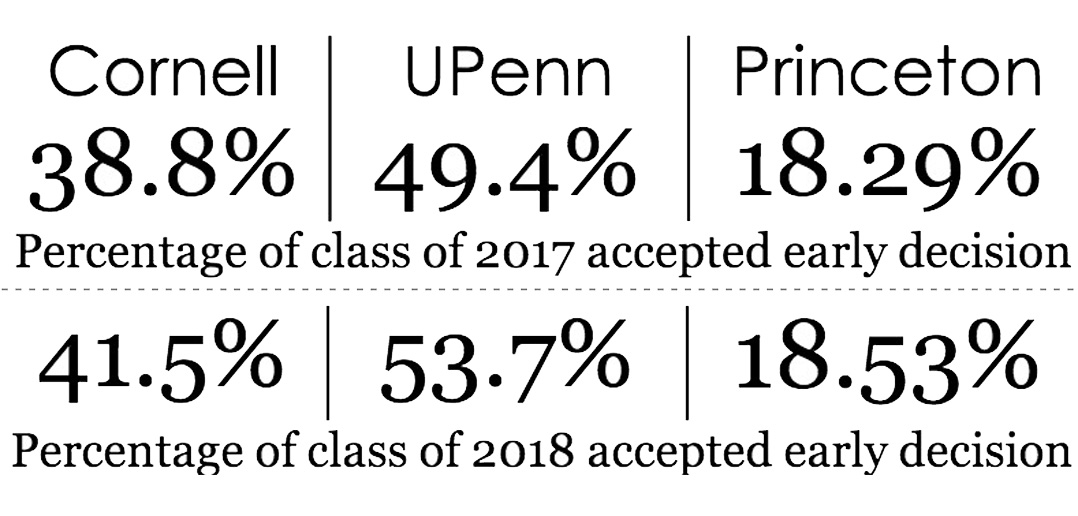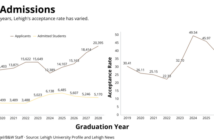With the acceptance of early decision applicants increasing nationally, prospective students are under more pressure to make their decisions as soon as possible – particularly when a school like Lehigh selected 46 percent of its freshman class from the early application pool.
Lehigh receives approximately 890 to 1100 early decision I and early decision II applications each year on Nov. 15.
“In terms of total applications, we see a very steady number of early decision I and early decision II applications,…which has been steady over the past decade,” said Bruce Bunnick, director of admissions at Lehigh.
When deciding whether to apply early decision, students must take into account what it means to send a school an early decision application. Such applications are binding if the university or college to which a student applies decides to accept their application.
If a student wants to show Lehigh that he or she is serious about enrolling, applying early “sends a fairly powerful message that the student has settled after conducting a thorough and exhaustive search of an institution,” Bunnick said. “They have made a profound statement that (Lehigh is their) No. 1 school.”
Applying early decision means that students are allowed to choose only one out of thousands of schools. With the fall deadline for early decision applications, however, students often do not have enough time to visit all of the schools on their list.
“Once I did my research and saw the reactions from people when I said I was thinking about applying, I knew I wanted to be one of the first students selected,” said Katie Pettis, ’16, who applied early decision to Lehigh.
For those students who want to show their interest without a binding contract upon acceptance, some schools offer an early action application. Students who apply for early action submit their applications at the same time as they would with an early decision application, but they can apply to as many schools as they want. If a school accepts the student, there is no contract in place that requires that student to attend.
According to Bunnick, Lehigh has traditionally offered early decision as opposed to early action and has done so for 20 to 25 years. Admissions plans to continue its early decision offerings.
“We feel that students come to campus and investigate us very deeply,” Bunnick said. “They find their passion here, they find an aspect or multiple aspects that they love, and they want to express that through an early decision program,” Bunnick said.
The Ivy League Coach, a consulting firm that helps top-tier high school students apply to Ivy League schools, tracks the acceptance statistics at these schools from past years to study and understand trends in admissions. Over the past few years, there has been a slight trend toward accepting a higher percentage of early decision students at these schools.
Statistics from Ivy League Coach’s website demonstrate that for the class of 2017, Cornell University filled 38.8 percent of its acceptances with students who applied early decision. The following year, Cornell increased that statistic to 41.5 percent for the class of 2018.
This same trend can be seen across other Ivy League schools such as the University of Pennsylvania and Princeton University, with both institutions increasing the percentage of the student body that was accepted from early decision applications from 49.4 percent to 53.7 percent and 18.29 percent to 18.53 percent, respectively.
Lehigh has been at the forefront of this trend, and has had a steady early decision acceptance rate over the past decade, Bunnick said. Forty-six percent of the class of 2018 were early decision applicants, which is a statistic higher than most of the Ivy League colleges’ ratios of regular admission students to early decision students.
“I applied ED because Lehigh was hands-down the best school,” Alex Stanislawski, ’15 said. “I tried to do anything I could to get in, (and early decision) was one of those choices. I just wanted to show Lehigh that if I chose ED, I was definitely going to come…The goal was to show them it was my top choice.”
Lehigh also offers an alternative option to applying early decision or regular decision, called early decision II. Early decision II is offered at the same time as regular decision but requires students to sign the same binding contract as early decision.
This second round of early decision was only implemented in 1999 due to the large amount of students who said they wished Lehigh was an early decision II school, according to Bunnick.
The early decision I application deadline occurs Nov. 15, while the early decision II application deadline is near the same time as the regular decision deadline of Jan. 15. Students may also change their regular decision application, which has a deadline of Jan. 1, to an early decision II application until Jan.15.






Comment policy
Comments posted to The Brown and White website are reviewed by a moderator before being approved. Incendiary speech or harassing language, including comments targeted at individuals, may be deemed unacceptable and not published. Spam and other soliciting will also be declined.
The Brown and White also reserves the right to not publish entirely anonymous comments.
2 Comments
In 1983 I was accepted to Lehigh, Early Decision by mid December, for the class of 1987.
It was one of the best things that ever happened to me. This is a great program, and has been successful at Lehigh for over 30 years now.
Great article! I’ve had my eyes set on Lehigh and I’m grateful the deadline was extended so I can express my aims to attend Lehigh!! Submitting my application tomorrow!